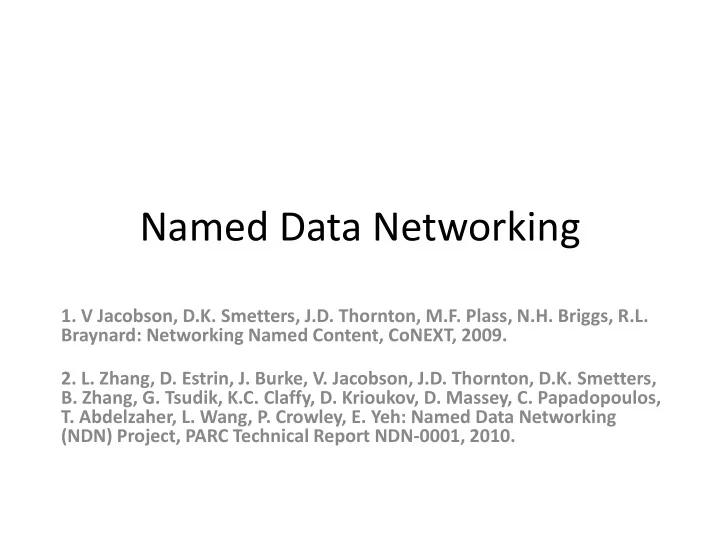

Named Data Networking 1. V Jacobson, D.K. Smetters, J.D. Thornton, M.F. Plass, N.H. Briggs, R.L. Braynard: Networking Named Content, CoNEXT, 2009. 2. L. Zhang, D. Estrin, J. Burke, V. Jacobson, J.D. Thornton, D.K. Smetters, B. Zhang, G. Tsudik, K.C. Claffy, D. Krioukov, D. Massey, C. Papadopoulos, T. Abdelzaher, L. Wang, P. Crowley, E. Yeh: Named Data Networking (NDN) Project, PARC Technical Report NDN-0001, 2010.
Named Hosts vs Named Data • Originally, networks dealt with the problem of scarce resources for service provision • However, information consumers are now less concerned with where the data is than what it is • “Liberating” content from its originator provides a way to tackle many of the problems with current network architecture: multicast, mobility, multipath • However, such an approach needs to be sufficiently compatible with existing technologies to be a viable alternative – i.e. it needs to be incrementally deployable 2
Interest and Data packets • There are two types of NDN packets: – Interest packets – Data packets 3
Naming • Data can be named using URI-like hierarchical variable length identifiers. • At the lowest levels of the hierarchy, content is separated into versions and segments • Content can be selected by specifying traversal rules in the interest packet 4
Forwarding Model Interests ClientA NDN Router ClientB Source NDN /datasource/content ClientC Router 5
Forwarding Model Interests Content ClientA Content NDN Router Content ClientB Source NDN /datasource/content ClientC Router 6
NDN Forwarding Engine 7
Transport Strategy • Each interest retrieves a single data packet. Applications retransmit unresolved interests. • Multiple interests can be sent simultaneously to provide flow control functionality • Each node in the network has its own strategy layer, which allows end-to-end flow control • Content segment numbers also act like TCP sequence numbers. Out-of-sequence segments are buffered in the content cache. 8
Routing • NDN needs a mechanism to allow link state advertisements that include the naming prefixes • Broadcast-based intra-domain routing protocols like OSPF include a type-label value field in their protocol that can be used • The FIB is updated with all matching interfaces for advertised name prefixes • For inter-domain routing, current versions of BGP also allow propagation of name prefix 9
Security and Privacy • Rather than authenticating endpoints, content segments are signed and optionally encrypted • Certificates linking namespaces to content can be propagated like any other content, allowing key exchange • Related content forms trust relationships and can be used to build evidence as to the authenticity of related content. • The nature of the routing model makes attacks such as DDoS less effective 10
Evaluation • The evaluation focuses on a small set of familiar applications, and shows how these operate under NDN • Focus is more on proving the concept, rather than on proving performance • Small scale trial of HTTP/S, VoIP and multicast 25/1/2010 11
Evaluation (cont.) 12
Pros • Conceptually elegant in the way it addresses some of the key issues affecting networks • Can also be used with real-time streams such as VoIP and • Can integrate with existing network hardware, utilising existing protocols • Evaluation shows that the scheme does provide performance benefits to content distribution 13
Cons • The scalability of flooding interests is questionable • The unbounded address space could be difficult to implement on current hardware – [2] proposes a way to tailor names to a global/site model to allow use with TCAM hardware • Arbitrary hierarchy could lead to untenable routing table growth • The current evaluation with less than ten clients does not provide very strong evidence of scalability • Evaluation also does not compare against other information-centric or traditional approaches 14
Questions / Comments?
Recommend
More recommend